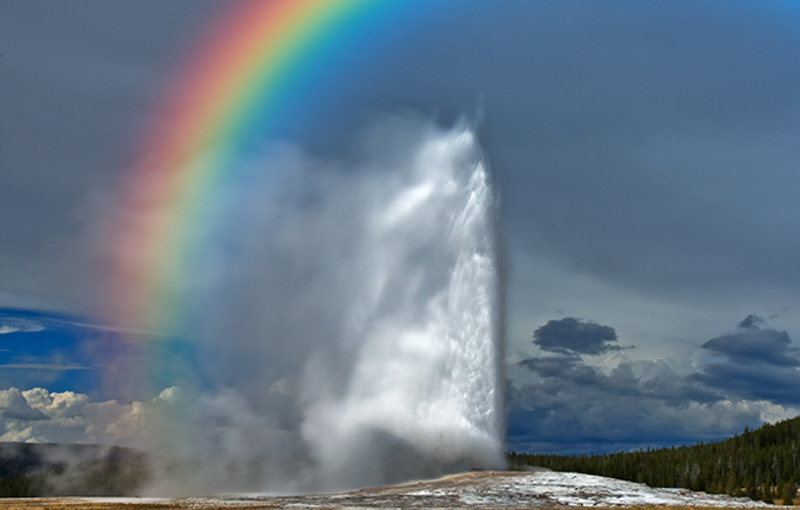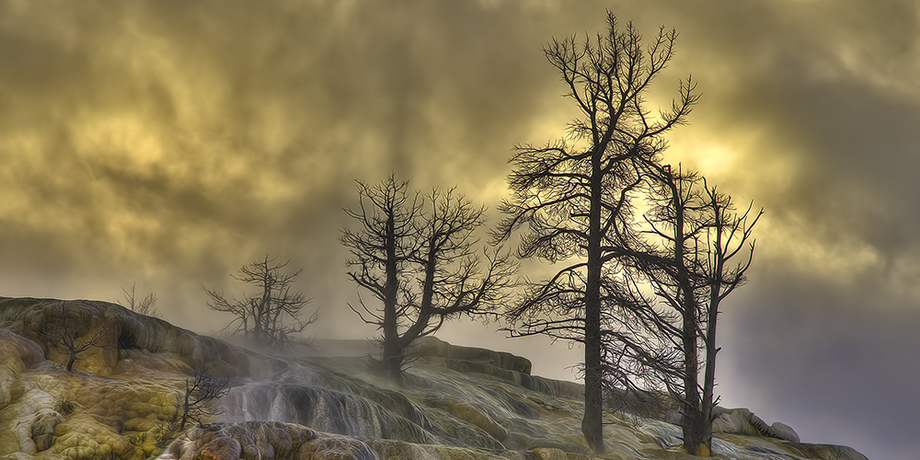The routes and access points for the thermal activity and other geologic formations at Yellowstone are relatively short, located either roadside or along walkways constructed for ease of viewing. That’s the good news. On the darker side, it’s an immense park and requires a fair amount of driving time. The park guidebooks list so many attractions that it’s hard to visualize just how to take it all in on a single visit. The timing of geyser eruptions can be especially heart breaking for photographers trying to cram too much into each day. The answer, as always, is to research and winnow out those that are most attractive for photography and skirt the rest, working with whatever the weather and the subterranean haunts might bring each day. We chose a couple of weeks in the latter part of August and early September to tackle this area, reserving several days for a quick trip to the Grand Tetons.
Yellowstone is best approached in five sections: Mammoth Hot Springs to Norris Geyser Basin; Grand Canyon of the Yellowstone to the Lamar Valley; Grand Prismatic Spring; Old Faithful Geyser; and, the West Thumb Geyser Basin to Hayden Valley. We planned roughly a day for each area with three tacked on to the end as a contingency for return visits if we missed a notable landmark, the weather was not cooperating or time simply didn’t permit completing our itinerary each day. For convenience, we used Gardiner, Montana as a home base for the first part of our visit and the West Entrance on our way back. You can see how we fared in Gallery 76 and read about the finer points of each location below.
We started at Boiling River with the hope that the mists and early morning light would create an ethereal look worth photographing. The trail starts at the parking lot and meanders south, finally reaching a small falls and rapids. It was disappointing as conditions were too warm to create the mist we were looking for.
The boardwalks at Mammoth Hot Springs housed our first look at the colorful and often desolate hydrothermal activity that characterizes much of Yellowstone. It’s easy to walk through the various terrace and spring locations. We found Palette Spring, Mound Terrace, Canary Spring and the Orange spring mound to be the most productive for photography. The boardwalks are serviceable but the nails protrude and a lot of the timber has aged and is in serious need of repair. If you want a better look at Canary Spring, park roadside at the bend approaching the Upper Terrace Drive and walk the lower path. The latter “drive” is well named as parking is at a premium and the asphalt is inundated with the most unbelievable potholes. It’s quite an introduction to the austerity measures hitting the National Park Service. You’ll find a 24-105mm lens will be suitable for most locations but a macro or long lens will be beneficial for some of the intimate boardwalk or distant thermal activity.
As you progress south, try Rustic Falls at Golden Gate. Positioning is tough but it can create a wonderful image if the light is right (this location is often in the shadows). Another potential stop is the Swan Lake Flats where Electric Peak and Sepulcher Mountain in the Gallatin Range can make a nice backdrop if the clouds have some character or there are Plains Bison grazing. If you like abstract photography, try the Sheepeater Cliffs as the columns of basalt rock make for great fare. Look for Pika, Golden Mantled Ground Squirrel and the ever present “mooching” Gray Jay at this location.
The Norris Geyser Basin is a series of boardwalks and trails similar to Mammoth. Silica forms the cones and slender edges of the hot springs, again fused with dramatic colors. The best choices here are the Black Growler Steam Vent, Emerald Spring and the Steamboat Geyser. To end our day we again tried the Mound Terrace at Mammoth Hot Springs for the evening light.
If you want a change of scenery from the ubiquitous thermal activity, canyons and waterfalls is a good choice. We started by taking in some backcountry along the Blacktail Plateau Drive in search of wildlife. Our first landscape destination was Tower Fall just past Roosevelt Junction. Although the water drops through stunning volcanic pinnacles, the short but steep half mile hike to the base was closed due to a washout. Between here and Mount Washburn there are several panorama opportunities of the Antelope Creek Valley. The real attraction of this area is the Upper and Lower Falls in what is called the Grand Canyon of the Yellowstone. The Upper Falls can be viewed from either the Brink of the Upper Falls Trail or from the overlook at Uncle Tom’s Trailhead. There is a metal stairway that descends to a spectacular view of the Lower Falls but it is a lung burner of a return climb. There are several places that offer good views of the Lower Falls, notably Lookout Point (along the North Rim Drive and best seen at the end of the short Red Rock Trail) and Artist Point (along the South Rim Drive). To end the day we drove through the Lamar Valley looking for colorful Aspen groves. Here, the evening light can cough up some stunning images. Be sure to look for Soda Butte, an extinct hot spring cone that looks out of place on the flat prairie landscape.
Before reaching this area, we made a quick stop just south of Norris Junction at the Chocolate Paint Pot. Heading toward the Lower Basin, we took the Firehole Canyon Drive with the intent of checking out the falls and swim holes along the river for locations that might be good for images that portray that silky flow of water. We also took the Fountain Flat Drive for a look at Ojo Caliente Spring. Then it was on to the extensive thermal and mud pot sites of the Lower and Midway Geyser Basins. The first is the Fountain Paint Pot, another easy to view, boardwalk area. Here the Clepsydra Geyser and Jelly Geyser are a definite morning event but the Silex Spring and Fountain Paint Pot require evening light.
Next was the Firehole Lake Drive. You might think that viewing each site might become tedious but from a photographers’ perspective you never know when the ever changing geology will suddenly display that blend of mist and color that can make for a truly stunning image. This location is a good example, requiring timing if you want to photograph the spectacle of an erupting Great Fountain or White Dome Geysers (estimated time of day is available at the Old Faithful visitor center). While you’re here, check out Surprise Pool as it is a stunning collage of color.
We stopped roadside at the entrance to the Midway Geyser Basin to photograph the Excelsior Geyser. A short distance down the road is the parking lot for the trail to Fairy Falls. It’s a five mile round trip but worth the trek. Along the way there is an elevated view of the Grand Prismatic Spring and many opportunities to capture the devastation and renewal caused by an earlier forest fire. The falls drops two hundred feet into a small misty pool and is a great photography opportunity.
This next area requires two full days to take in. Before getting to the Upper Geyser Basin and the parks main attraction, there is more thermal activity to wade through. At Biscuit Basin try Sapphire Pool, Shell Spring, Avoca Spring and the Mustard Springs. There is a three mile loop at the last spring that takes you to the Mystic Falls Overlook. Again it’s not a strenuous hike and worth the time if you have it. The second is the black obsidian area known as Black Sand Basin. Here the pools and geysers are some of the most colorful in the park. We found Opalescent Pool, Emerald Pool and the Spouter Geyser offered the best photography opportunities.

The final stop and the one that takes the most time in this area is the Upper Geyser Basin that houses the parks visitor center and the Old Faithful Geyser. It’s best to check in here the day before you plan your visit and get a map and list of the estimated eruption times for the various features. You should also be aware that getting too close during an eruption event might result in a hot “silica mist” coating on your lens or glasses. If it is allowed to cool it will be impossible to remove so it’s best to wipe it off quickly and clean the lens. It’s an easy area to work as the paths are either paved or have a boardwalk but the crowds often make positioning difficult. Definites here are Morning Glory Pool, Punch Bowl Spring, Daisy Geyser, Grotto Geyser, Giant Geyser, Beauty Pool, Sawmill Geyser, Crested Pool, Castle Geyser, Shield Spring, Heart Spring, Beehive Geyser, Blue Star Spring and, of course, Old Faithful Geyser.
If thermal activity has exhausted you, try the nearby Kepler Falls to end the day. The Firehole River cascades down a one hundred foot drop that can be great to photograph if the light is right and you can find a decent position.
This is a small geyser basin that has spectacular backdrops of Yellowstone Lake and the Absaroka Mountains. At this time of year many of the submerged features are exposed due to the low lake level, making for a more exciting photography experience. It’s a midday experience as afternoon light casts shadows from the boardwalk railings. Wind can also ruin this location for photography. We enjoyed Seismograph Pool, Abyss Pool, Black Pool and both the Big and Fishing Cones. Heading home, the open range of the Hayden Valley also provides good panorama opportunities. As you approach this area, the Mud Volcano and Sulphur Caldron are two must stops that will complete your visit to this area.
Grand Teton National ParkAs Yellowstone was the major focus of our trip, we decided to devote only a short time to this area, hitting the high spots only. Our rationale was that landscape photography in this area is primarily a morning event, forcing us to limit the locations we could realistically visit given the time available. Moreover, it’s arguably a better late fall or early winter event as snow adds definite character to the locations that are must stops. However, this is a good time of year for wildlife as the progressively colder mornings have them up and moving. Two must landscape locations are the beaver pond at Lower Schwabacher’s Landing and John Moulton’s Barn along Mormon Row. You need to be at both locations before sunrise. If you want to stretch your HDR skills, try an image through the window from the interior of J. Pierce Cunningham’s Cabin.
We found the wildlife to be very active along the Gros Vendre Road, especially for Moose munching Willow leaves along the river. The top of Signal Mountain is a good bet for Blue Grouse in the evening.
